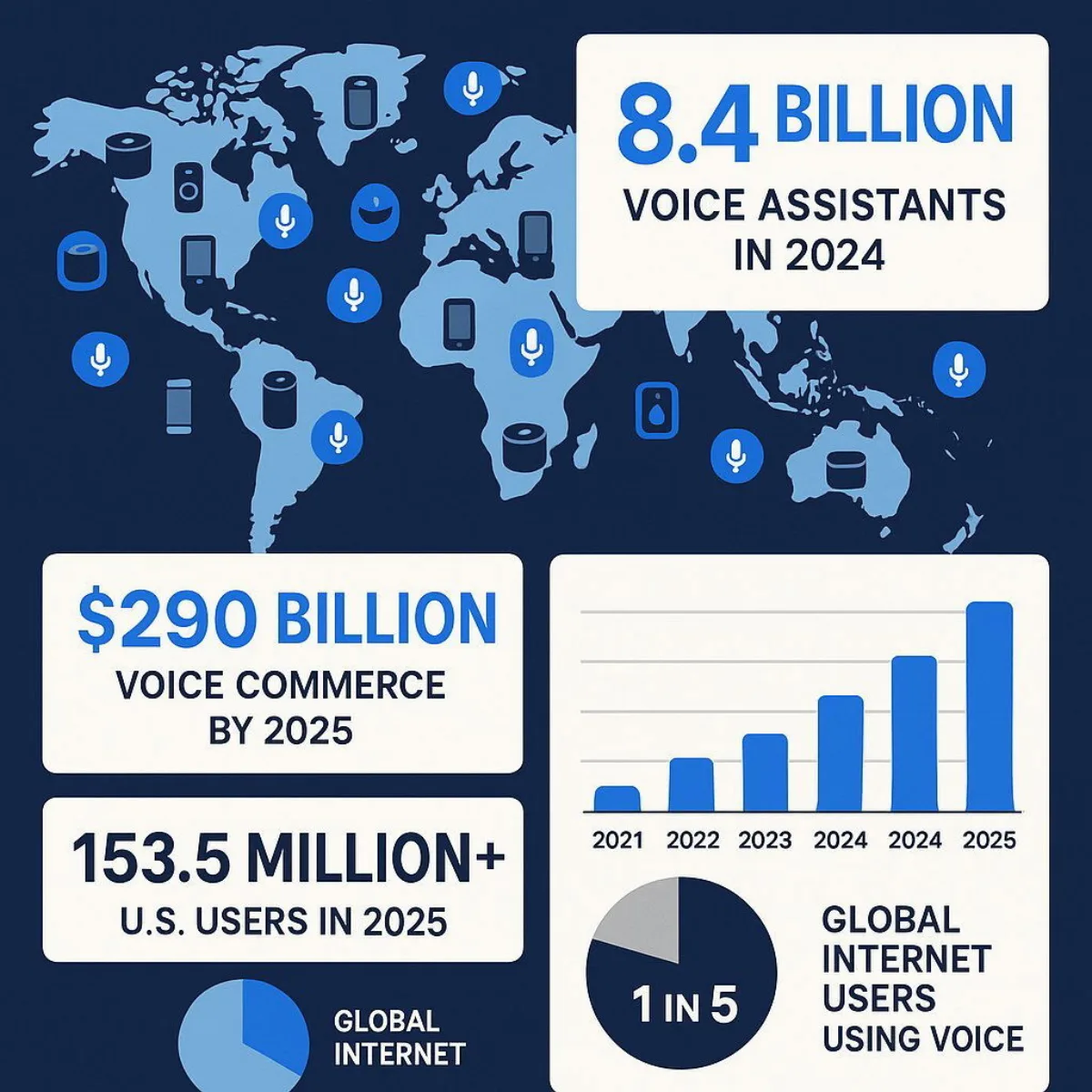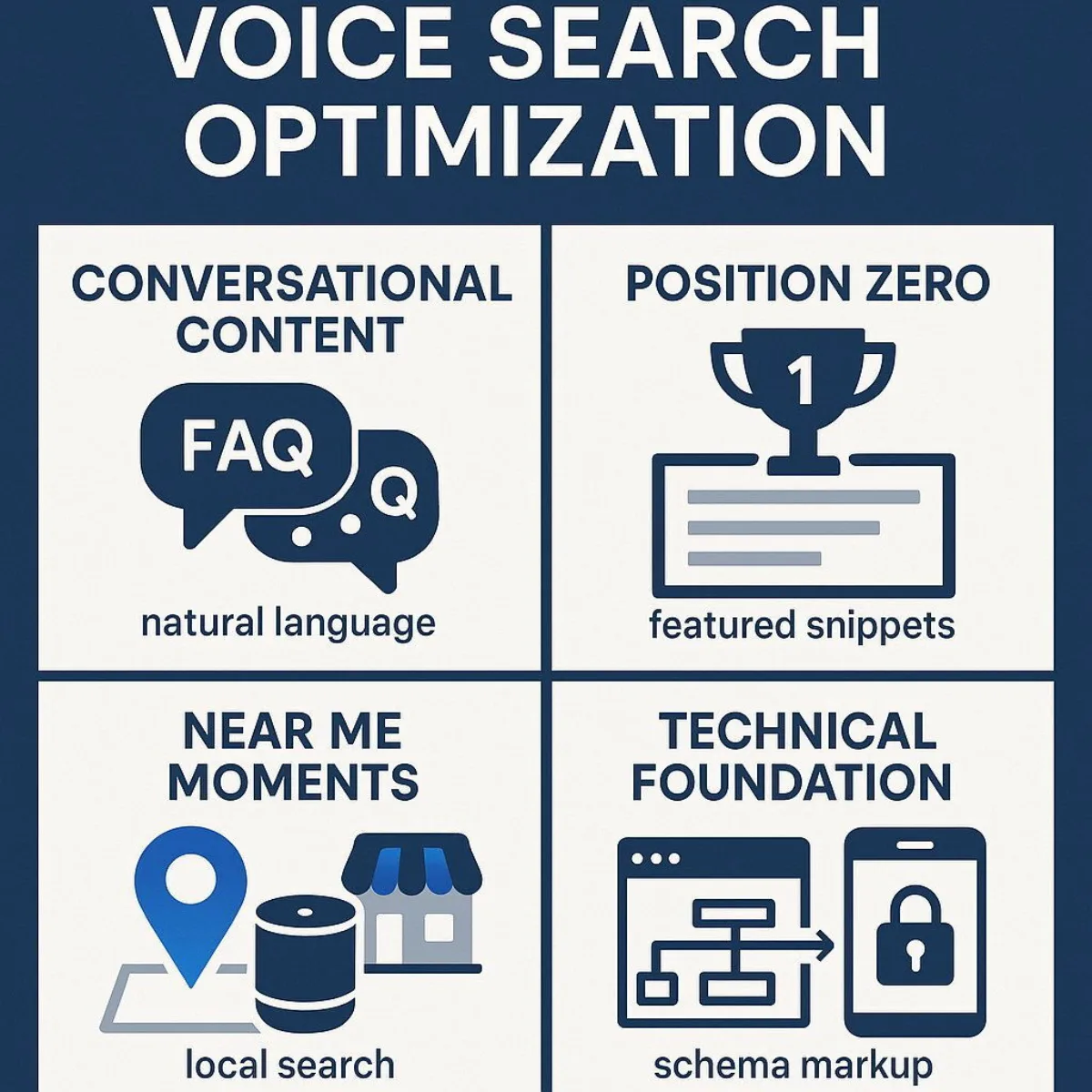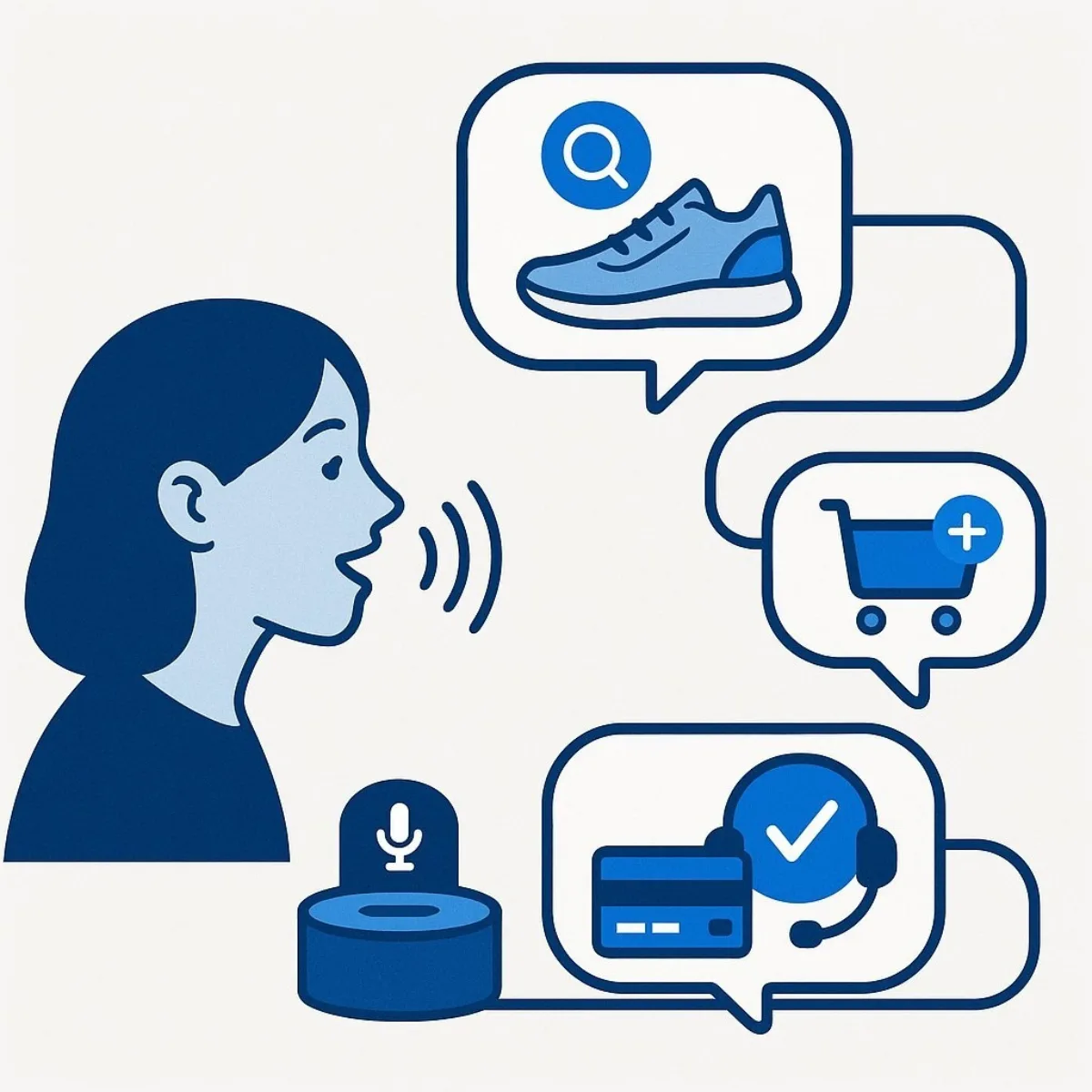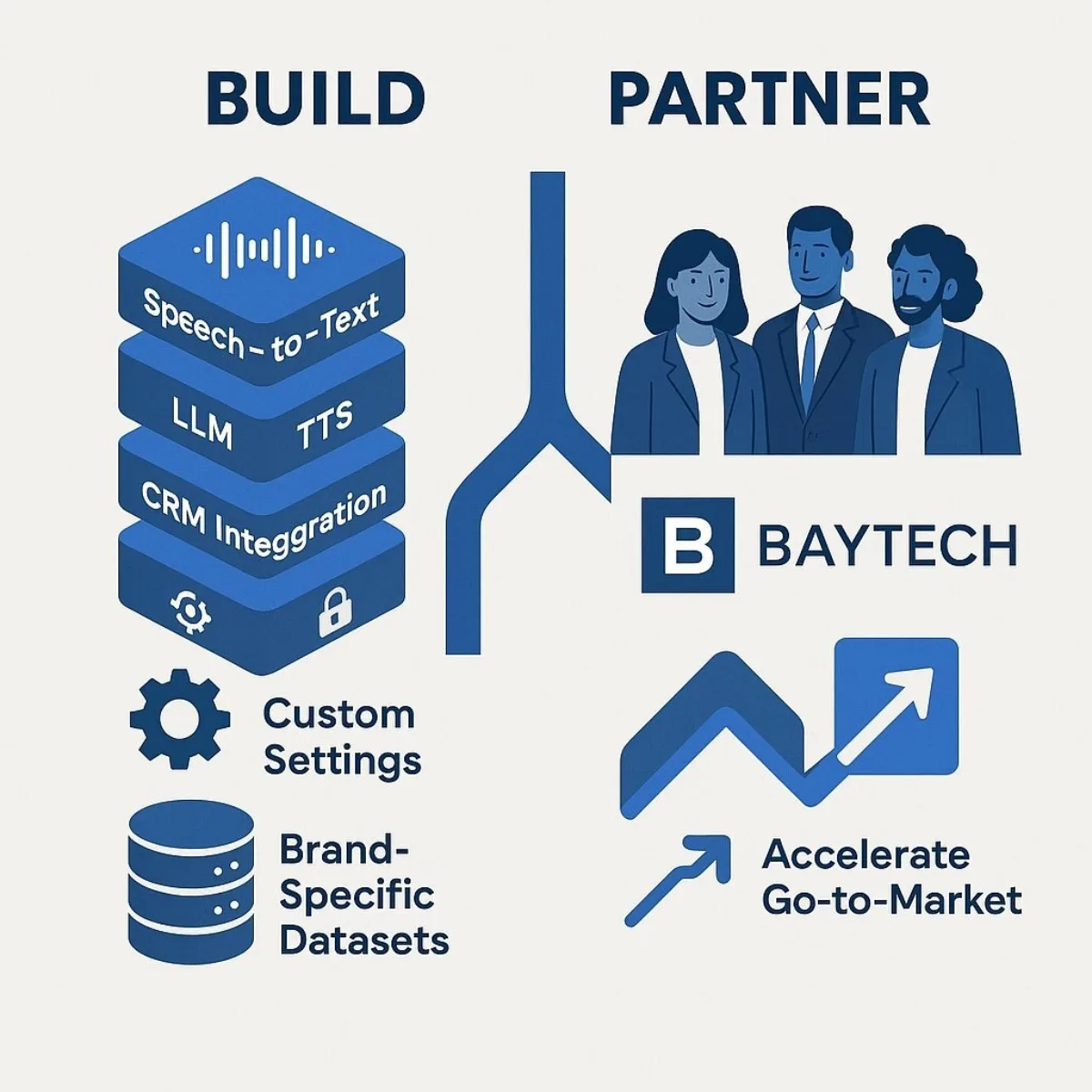
How Voice Search & Conversational AI Are Shaping the Future of Customer Experience
October 02, 2025 / Bryan ReynoldsVoice Search and Conversational AI: Your Guide to the Next Frontier of Customer Interaction
Your Customers Have a New Voice. Are You Listening?
Imagine your ideal customer. Perhaps they are driving to a meeting and ask their car's navigation system, "Find the highest-rated coffee shop near my next appointment." Later, in their kitchen, they tell a smart speaker, "Add organic milk and coffee beans to the shopping list." While walking through a store, they ask their smartphone, "Show me reviews for this brand of running shoes." Each of these moments represents a fundamental shift in how people interact with technology and, by extension, with your brand. This is not a futuristic trend; it is a present-day reality.
Voice is no longer just another channel to manage; it has become a primary human-computer interface, as transformative as the leap from desktop to mobile. The frictionless, hands-free nature of voice interaction is reshaping consumer expectations for speed, convenience, and personalization. For Chief Marketing Officers and Heads of Customer Experience, this evolution presents both a significant challenge and an unprecedented opportunity. Staying competitive requires moving beyond simple awareness and into strategic action. This guide provides a data-backed roadmap to navigate this new landscape, answering the critical "why, what, and how" of integrating a voice-first strategy into the core of your business.
Why Is Voice Technology a C-Suite Priority? The Data-Backed Reality
The question for executive leadership is no longer if voice will become a dominant force, but rather how to adapt to the reality that it already is. The scale of adoption has created an "ambient computing" environment, where voice is not a destination like a website, but a pervasive utility integrated into the fabric of daily life—in homes, cars, and on personal devices. This fundamentally changes the context of customer interaction from discrete, screen-based sessions to continuous, on-the-go engagement opportunities. The data paints a clear picture of a revolution that is already well underway, making a voice strategy a non-negotiable item for any forward-thinking C-suite.
The proliferation of voice-enabled devices is staggering. By 2024, the number of digital voice assistants in use was projected to reach 8.4 billion worldwide—a figure that exceeds the global population, indicating that the average connected consumer interacts with multiple voice touchpoints daily. This is not a niche, early-adopter phenomenon. In the United States alone, the number of adults using voice assistants is expected to surpass 153.5 million in 2025 and continue to climb to 157 million by 2026. Globally, approximately one in five internet users—a massive and established market segment—already leverages voice commands to search online.
This widespread adoption has paved the way for a new, high-growth transactional channel: voice commerce. The global voice commerce market is experiencing explosive growth, with projections varying but all pointing to a massive opportunity. One forecast estimates the market will reach $186.28 billion by 2030, while another projects a global spend of $290 billion as early as 2025. To put this growth in perspective, global voice shopping spend was just $4.6 billion in 2021; by 2025, it is projected to approach $82 billion. This is not just about search and discovery; it is about a multi-billion dollar revenue stream that is rapidly maturing.

| Metric | 2025 Projection | 2030 Projection | Key Implication |
|---|---|---|---|
| Global Voice Assistant Devices | >8.4 Billion (by end of 2024) | ~ 40 Billion IoT Devices | Voice is an ambient, always-on interface, not a single channel. |
| U.S. Voice Assistant Users | 153.5 Million+ Adults | 157 Million+ Adults (by 2026) | The target audience is mainstream, not a niche segment. |
| Global Voice Commerce Market | $81.8 - $290 Billion | $186.28 Billion+ | A significant, high-growth transactional channel is emerging. |
| Share of E-commerce via Voice | - | 30% | Voice will be a primary driver of future e-commerce revenue. |
How Is Voice Search Different from the SEO We Already Know?
For years, marketing leaders have invested heavily in mastering Search Engine Optimization (SEO), building teams and strategies around keywords, backlinks, and page rankings. However, the rise of voice necessitates a fundamental re-evaluation of this playbook. Voice Search Optimization (VSO) is not merely an extension of traditional SEO; it is a distinct discipline governed by different user behaviors and technological responses.
The most critical distinction lies in the nature of the search query itself. A user typing into a search bar uses fragmented, abbreviated language—think "best pizza near me." This text-based query averages just three to four words. In contrast, a user speaking to a voice assistant uses natural, conversational language, asking a complete question as they would to another person: "Where can I find the best pizza in my area?" This type of voice query averages 29 words in length. This shift from keywords to questions is the foundational difference that impacts every subsequent aspect of strategy.
This change in user input fundamentally alters the search engine's output. A traditional text search yields a Search Engine Results Page (SERP)—a list of ten blue links that functions as a menu of options for the user to choose from. A voice search, designed for a frictionless, hands-free experience, bypasses this menu entirely. Instead, the voice assistant delivers a single, definitive spoken answer. This creates a binary, "winner-take-all" environment where brand visibility is absolute. For a given query, a brand is either
the answer, or it is entirely invisible.
The data underscores this dynamic. Over 80% of answers delivered by Google's voice assistant are sourced from the top three organic search results, and a staggering 40.7% are pulled directly from the "Featured Snippet" (also known as "Position Zero")—the answer box that appears at the very top of the results page. This makes securing that top position exponentially more valuable in VSO than in traditional SEO, where a ranking of #2 or #3 still offers significant visibility and click-through potential.
| Feature | Traditional SEO | Voice Search Optimization (VSO) |
|---|---|---|
| User Query Style | Short, fragmented keywords | Long, conversational questions |
| Keyword Focus | Short-tail & long-tail keywords | Question-based, natural phrasing |
| Search Result Format | Page of ranked links (SERP) | Single, spoken answer (Featured Snippet) |
| Primary Goal | Rank on Page 1, drive clicks | Become the definitive answer |
| Content Strategy | Blog posts, landing pages targeting keywords | FAQ pages, structured data, direct answers |
| Key Ranking Factors | Backlinks, domain authority, keyword density | Content clarity, schema, local signals |
How Do We Win the 'Answer Engine'? A CMO's Playbook for Voice Search Optimization (VSO)

Winning in the voice-first era requires a strategic pivot from optimizing for search engines to engineering answers for customers. This is not a task that can be delegated to a single team; it demands an integrated approach that treats content as a structured data asset. Here is a CMO's playbook for building a dominant presence in voice search, organized around four core pillars.
1. Master Conversational Content
The primary goal is to shift the content mindset from "writing for Google" to "answering for a customer." This means creating content that directly and comprehensively addresses the "who, what, where, when, why, and how" questions your audience is actively asking. The content must be framed in natural language, mirroring how people actually speak. Research shows that voice search results are typically written at a 9th-grade reading level, emphasizing the need for clarity and simplicity over complex jargon. The most effective tactic is to build robust FAQ pages and structure all content with question-based headings, followed immediately by a direct answer. If you're developing content for agile methodology or optimizing for voice, approaching content through this lens is key.
2. Capture 'Position Zero'
The Featured Snippet is the holy grail of VSO. As it is the source for over 40% of voice answers, optimizing for this position is the most direct path to being heard. To achieve this, content must be structured to provide concise, definitive answers. The ideal length for a snippet is between 40 and 50 words. Structuring answers using bulleted lists, numbered steps, or clear definitions makes it easy for search algorithms to parse the information and elevate it into the snippet position. This requires a new form of content engineering, where the answer is crafted just as carefully as the surrounding article.
3. Dominate 'Near Me' Moments
Voice search is inherently local and immediate. Approximately 76% of smart speaker searches have local intent, with users looking for businesses, directions, or services in their immediate vicinity. Furthermore, 58% of consumers specifically use voice to find information about local businesses. For any brand with a physical footprint, dominating these "near me" moments is non-negotiable. The cornerstone of local VSO is claiming and meticulously optimizing your Google Business Profile. This includes ensuring absolute consistency of your Name, Address, Phone number, and Website (NAPW) across all online directories, as voice assistants pull data from multiple sources to verify information. Actively encouraging customer reviews and creating location-specific landing pages with local keywords are also critical tactics.
4. Build the Technical Foundation
Voice assistants are built for speed and reliability, and they favor websites that reflect these qualities. A strong technical foundation is essential for VSO. This starts with implementing Schema markup, which is a form of structured data that gives search engines explicit context about your content. It tells them, "This section is an FAQ," "This is a product review," or "These are our business hours," making it far easier for them to pull accurate information for a voice response. Given that smartphones are the number one device for voice search, a mobile-friendly, responsive website is paramount. Finally, page load speed and security are crucial; a fast-loading site provides a better user experience, and data shows that over 70% of URLs in voice search results use secure HTTPS, compared to just 50% of desktop results. If you are invested in reliability and performance, consider approaches aligned with DevOps efficiency and cloud-native best practices; these can make a crucial difference.
Beyond Search: What is Conversational Commerce and How Does It Impact the Bottom Line?

While VSO is critical for discovery, the true revolution in customer interaction lies in using conversational interfaces to drive transactions. This is the domain of Conversational Commerce: the strategic fusion of AI-driven messaging, chat, and voice to guide shoppers seamlessly through their entire journey, from initial query to final purchase and post-sale support. This approach is not just a new sales channel; it is a mechanism for collapsing the traditional sales funnel.
In a typical e-commerce journey, a customer moves through multiple distinct steps: searching, clicking a link, browsing a product page, adding an item to a cart, navigating to a checkout page, filling out forms, and finally, paying. Each step introduces friction and represents a potential point of abandonment. Conversational Commerce eliminates this friction by allowing a customer to move from a research query ("Do you have waterproof hiking boots in a size 10?") directly to a transactional command ("Great, order the brown ones for me") within a single, continuous dialogue. This creates a near-frictionless path to purchase, which directly explains the dramatic improvements in business outcomes.
The market data reflects this powerful value proposition. The global conversational commerce market is projected to grow from approximately $11 billion in 2024 to over $52 billion by 2034, with some analysts forecasting a global spend of $290 billion as early as 2025. This growth is fueled by tangible ROI. Companies that implement AI chat assistants report conversion rate increases of up to 35%. Furthermore, effective personalization delivered through these conversational channels can reduce customer acquisition costs by up to 50% while boosting overall revenue by 5-15%. With nearly half of U.S. consumers having already used voice for shopping-related activities and 80% of businesses planning to use AI-driven voice technology in their customer service operations by 2026, the shift from conversational search to conversational commerce is well underway.
How Do We Build Our Voice-First Future? The Strategic 'Build vs. Partner' Decision
Recognizing the strategic imperative of voice is the first step. The second, more complex step is implementation. Building a truly differentiated, brand-aligned voice experience is a sophisticated technological undertaking that goes far beyond the capabilities of most marketing and customer experience departments.
Developing a custom voice AI application requires a complex technology stack, including best-in-class models for Speech-to-Text (STT), a Large Language Model (LLM) for understanding and reasoning, and Text-to-Speech (TTS) for generating a natural-sounding response. All of these components must work in concert with sub-second latency to create a seamless user experience. Businesses face significant technical hurdles, including ensuring high accuracy in speech recognition across diverse accents and noisy environments, enabling seamless integration with core business systems like CRM and inventory management, and guaranteeing robust data privacy and security—a critical concern for customers.
This reality presents a strategic choice for CMOs and CX leaders: rely on generic, off-the-shelf tools that offer little competitive differentiation, or invest in building a proprietary voice interface that becomes a core strategic asset. While the challenges of a custom build are significant, the rewards are substantial. A proprietary voice assistant can be trained on a company's unique product catalog, customer data, and internal knowledge bases, allowing it to perform complex, industry-specific tasks that generic solutions cannot. For example, an industrial equipment supplier could build a voice assistant that helps field technicians identify and order a specific part by describing the machine's symptoms—a powerful competitive moat. With 89% of customers stating they prefer brands that offer voice AI support, a custom solution is a direct investment in customer loyalty.

This is where a strategic development partner becomes essential. A firm like Baytech Consulting provides the specialized expertise required to navigate this complexity. Baytech acts as the bridge between a company's strategic vision and the complex engineering required to bring it to life. They bring deep expertise in Natural Language Processing, multimodal AI models, and real-time communication infrastructure, de-risking the investment for their clients. By partnering with Baytech, a CMO can focus on crafting the ideal customer experience strategy—defining the assistant's persona, conversation flows, and business goals—while a team of expert engineers handles the intricate work of building a robust, scalable, and secure voice platform that integrates seamlessly with the existing technology stack. This partnership model accelerates time-to-market and ensures the final product is not just a marketing campaign, but a durable, differentiated brand asset that will define the future of customer interaction.
Conclusion: Your First Steps in the Voice Revolution
The transition to a voice-first world is not a distant forecast; it is the current state of digital interaction. For marketing and customer experience leaders, inaction is no longer a viable option. The data is conclusive: voice is a primary customer interface, its adoption is nearly universal, and the commercial opportunities are measured in the hundreds of billions of dollars.
Winning in this new arena requires a fundamental strategic shift. It means moving from a content strategy based on keywords to one architected around answers. It means recognizing that in the world of voice search, you are either the single, definitive answer or you are invisible. It means embracing Conversational Commerce as a high-growth revenue channel that offers a superior, frictionless customer experience.
The path forward begins with a clear-eyed assessment of your organization's current capabilities and readiness. The time for a "Voice Readiness Audit" is now. As a leader, you should begin by asking your teams these critical questions:
- How do we currently perform for the question-based queries that are central to our customers' journey?
- Is our local business information 100% accurate and consistent across every online directory where a voice assistant might find it?
- What are the top two or three customer interactions—be it in sales, support, or service—that could be fundamentally transformed and improved with a custom conversational AI interface?
The answers to these questions will form the foundation of your voice strategy and illuminate the path toward owning the next frontier of customer interaction.
Further Reading
- The Impact of Voice Technology on Digital Marketing Strategies - https://breakthrough3x.com/resources/the-impact-of-voice-technology-on-digital-marketing-strategies/
- Harnessing Conversational AI to Transform Customer Experience - https://www.tp.com/en-us/insights-list/insightful-articles/global/harnessing-conversational-ai-to-transform-customer-experience/
- Beyond Traffic: The CMO's Guide to Content Strategy in the AI Era - https://www.conductor.com/academy/cmo-strategy-guide/
About Baytech
At Baytech Consulting, we specialize in guiding businesses through this process, helping you build scalable, efficient, and high-performing software that evolves with your needs. Our MVP first approach helps our clients minimize upfront costs and maximize ROI. Ready to take the next step in your software development journey? Contact us today to learn how we can help you achieve your goals with a phased development approach.
About the Author

Bryan Reynolds is an accomplished technology executive with more than 25 years of experience leading innovation in the software industry. As the CEO and founder of Baytech Consulting, he has built a reputation for delivering custom software solutions that help businesses streamline operations, enhance customer experiences, and drive growth.
Bryan’s expertise spans custom software development, cloud infrastructure, artificial intelligence, and strategic business consulting, making him a trusted advisor and thought leader across a wide range of industries.


